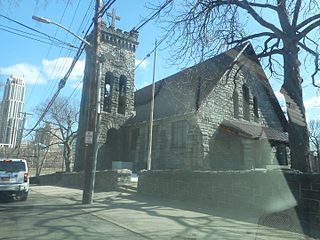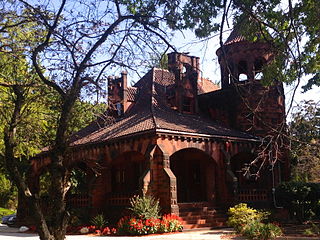
The Lincoln Tomb is the final resting place of the 16th President of the United States, Abraham Lincoln; his wife, Mary Todd Lincoln; and three of their four sons, Edward, William, and Thomas. It is located in Oak Ridge Cemetery in Springfield, Illinois. Constructed of granite, the tomb has a large, single-story rectangular base, surmounted by an obelisk, with a semicircular receiving room entranceway, on one end, and semicircular crypt or burial-room opposite.

The Chicago Cultural Center, opened in 1897, is a Chicago Landmark building operated by Chicago's Department of Cultural Affairs and Special Events that houses the city's official reception venue where the Mayor of Chicago has welcomed Presidents and royalty, diplomats and community leaders. It is located in the Loop, across Michigan Avenue from Millennium Park. Originally the central library building, it was converted in 1977 to an arts and culture center at the instigation of Commissioner of Cultural Affairs Lois Weisberg. The city's central library is now housed across the Loop in the spacious, postmodern Harold Washington Library Center opened in 1991.

Monreale Cathedral is a Roman Catholic church in Monreale, Metropolitan City of Palermo, Sicily, southern Italy. One of the greatest existent examples of Norman architecture, it was begun in 1174 by William II of Sicily. In 1182 the church, dedicated to the Nativity of the Virgin Mary, was, by a bull of Pope Lucius III, elevated to the rank of a metropolitan cathedral as the seat of the diocese of Monreale, which was elevated to the Archdiocese of Monreale in 1183. Since 2015 it has been part of the Arab-Norman Palermo and the Cathedral Churches of Cefalù and Monreale UNESCO World Heritage site.

The Tiffany and Company Building, also known as the Tiffany Building and 401 Fifth Avenue, is an eight-story commercial building at Fifth Avenue and 37th Street in the Midtown Manhattan neighborhood of New York City. The structure was designed in the Renaissance Revival style by Stanford White of McKim, Mead & White. It was built from 1903 to 1905 as the flagship store of jewelry company Tiffany & Co. The building is a New York City designated landmark and a National Historic Landmark.

The James A. Garfield Memorial is a memorial dedicated to and the final resting place of assassinated President James A. Garfield and located in Lake View Cemetery in Cleveland, Ohio, in the United States. The memorial, built from is a combination of Byzantine, Gothic, and Romanesque Revival styles, began construction in October 1885 and was dedicated on May 30, 1890. Garfield; his wife, former First Lady Lucretia Garfield; and two other members of the Garfield family are entombed in the crypt level of the monument.

Riverside Cemetery Chapel is a historic chapel located in Riverside Cemetery at 3607 Pearl Road in Cleveland, Ohio. It was built in 1876, received an addition in 1897, and closed due to disrepair in 1953. It was added to the National Register of Historic Places in 1987. It underwent a major renovation beginning in 1995, and reopened in 1998.

Civita Castellana Cathedral is a cathedral in Civita Castellana, central Italy. It is the episcopal seat of the Diocese of Civita Castellana.

The Tiffany Chapel is a chapel interior designed by Louis Comfort Tiffany and created by the Tiffany Glass and Decorating Company. First installed for the 1893 World's Columbian Exposition in Chicago, the chapel was later moved to the Cathedral of St. John the Divine in New York City, then re-acquired by Tiffany in 1916 and displayed in his own home. After the chapel was dismantled in 1949, parts were sold and the remaining portions were put on display at the Charles Hosmer Morse Museum of American Art in Winter Park, Florida in April 1999.

Lake View Cemetery is a privately owned, nonprofit garden cemetery located in the cities of Cleveland, Cleveland Heights, and East Cleveland in the U.S. state of Ohio. Founded in 1869, the cemetery was favored by wealthy families during the Gilded Age, and today the cemetery is known for its numerous lavish funerary monuments and mausoleums. The extensive early monument building at Lake View helped give rise to the Little Italy neighborhood, but over-expansion nearly bankrupted the burial ground in 1888. Financial recovery only began in 1893, and took several years. Lake View grew and modernized significantly from 1896 to 1915 under the leadership of president Henry R. Hatch. The cemetery's cautious management allowed it to avoid retrenchment and financial problems during the Great Depression.

Hubbell & Benes was a prominent Cleveland, Ohio architectural firm formed by Benjamin Hubbell (1857–1935) and W. Dominick Benes (1867–1953) in 1897 after the pair departed from Coburn, Barnum, Benes & Hubbell. Their work included commercial and residential buildings as well as telephone exchange buildings, the West Side Market and Cleveland Museum of Art. Before teaming up, they worked for Coburn and Barnum. Benes was Jeptha Wade’s personal architect and designed numerous public buildings, commercial buildings, and residences for him including the Wade Memorial Chapel.

The Citizens Building is a high-rise office and retail building located at 840 Euclid Avenue in Cleveland, Ohio, in the United States. The structure was built in 1903 by the Citizens Savings and Trust, a local bank. Its entrance portico was removed in 1924, and a two-story addition erected in its place. Home to the City Club of Cleveland since 1982, the building was renamed the City Club Building in 1999.

The Parish of St. Gabriel and of St. Joseph was formed in August 2015 with the merger of the Territorial parish of St. Gabriel on Division Street with the personal parish of St. Joseph on Washington Avenue, both in New Rochelle, NY. St. Gabriel is the parish church. However, St. Joseph "will maintain a regular schedule of Masses and the celebration of other sacraments". Both parishes were established around 1900 through the generosity of the Iselin family.

Abbey Mausoleum was a mausoleum in Arlington County, Virginia, in the United States founded in 1924. One of the most luxurious burial places in the Washington, D.C., metropolitan area, many famous individuals, judges, and military leaders were buried there. The mausoleum encountered financial difficulties and declared bankruptcy in 1966. It suffered vandalism numerous times, and several graves were desecrated. Remains buried there were disinterred and reburied elsewhere, and it was demolished in February 2001. Several architectural features of the structure were salvaged. It was located just outside Arlington National Cemetery next to Henderson Hall.

The Cleveland Trust Company Building is a 1907 building designed by George B. Post and located at the intersection of East 9th Street and Euclid Avenue in downtown Cleveland's Nine-Twelve District. The building is a mix of Beaux-Arts, Neoclassical, and Renaissance Revival architectural styles. It features a glass-enclosed rotunda, a tympanum sculpture, and interior murals.

Mayfield Cemetery is a historic Jewish cemetery located at 2749 Mayfield Road in Cleveland Heights, Ohio. Established in 1890, it is one of the largest Jewish cemeteries in Cuyahoga County and the only Jewish garden cemetery. A chapel was constructed in 1893. This was demolished and a large mausoleum, which included a chapel, was built in 1930.

Riverside Cemetery Gatehouse is a historic office building located in Riverside Cemetery at 3607 Pearl Road in Cleveland, Ohio. It was completed in 1897, and added to the National Register of Historic Places in 1987. A significant interior renovation occurred about 1991 to 1992.

Knollwood Cemetery is a cemetery located at 1678 SOM Center Road in Mayfield Heights, Ohio. Established in 1908, it is one of the largest cemeteries in Cuyahoga County. A mausoleum was completed in 1926, and an expansion finished in 1959. The cemetery's mausoleum, the largest in the state, boasts a number of windows by Tiffany & Co.

Wentworth Mausoleum is a heritage-listed mausoleum located at 5 Chapel Road, Vaucluse in the Municipality of Woollahra local government area of New South Wales, Australia. It was built from 1872 to 1874 by Mansfield Brothers, architects. It is also known as Wentworth Mausoleum and site. The property is owned by Anglican Church Property Trust and is managed by Sydney Living Museums as part of Vaucluse House. It was added to the New South Wales State Heritage Register on 2 April 1999.
Art Nouveau temples are churches, chapels, synagogues, and mosques built in the style known as Art Nouveau in French and English languages, Jugendstil in Germany and Nordic countries, Secessionsstil in countries of former Austro-Hungary, Modernisme in Catalan or Modern in Russian. As National Romantic style is also referred to Art Nouveau, churches of that style are also listed here, as well as some temples not of pure Art Nouveau style but with distinctive Art Nouveau features.

The Monumental Cemetery of Mortara is located in the north-eastern outskirts of the city of Mortara, an Italian comune in the province of Pavia, in the region of Lombardy in northern Italy. The Monumental Cemetery of Mortara is one of the biggest and most important cemeteries in the Lomellina area.























